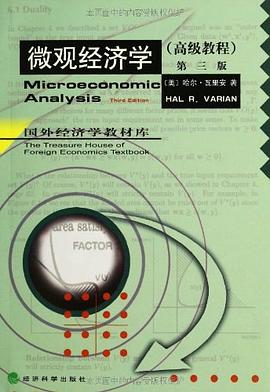

具体描述
《大学计算机教育国外著名教材系列:算法设计(影印版)》是近年来关于算法设计和分析的不可多得的优秀教材。《大学计算机教育国外著名教材系列:算法设计(影印版)》围绕算法设计技术组织素材,对每种算法技术选择了多个典型范例进行分析。《大学计算机教育国外著名教材系列:算法设计(影印版)》将直观性与严谨性完美地结合起来。每章从实际问题出发,经过具体、深入、细致的分析,自然且富有启发性地引出相应的算法设计思想,并对算法的正确性、复杂性进行恰当的分析、论证。《大学计算机教育国外著名教材系列:算法设计(影印版)》覆盖的面较宽,凡属串行算法的经典论题都有涉及,并且论述深入有新意。全书共200多道丰富而精彩的习题是《大学计算机教育国外著名教材系列:算法设计(影印版)》的重要组成部分,也是《大学计算机教育国外著名教材系列:算法设计(影印版)》的突出特色之一。
作者简介
目录信息
Preface
Introduction: Some Representative Problems
1.1 A First Problem: Stable Matching
1.2 Five Representative Problems
Solved Exercises
Exercises
Notes and Further Reading
Basics of Algorithm Ana/ys/s
2.1 Computational Tractability
2.2 Asymptotic Order of Growth
2.3 Implementing the Stable Matching Algorithm Using Lists and Arrays
2.4 A Survey of Common Running Times
2.5 A More Complex Data Structure: Priority Queues
Solved Exercises
Exercises
Notes and Further Reading
3 Graphs
3.1 Basic Definitions and Applications
3.2 Graph Connectivity and Graph Traversal
3.3 Implementing Graph Traversal Using Queues and Stacks
3.4 Testing Bipaniteness: An Application of Breadth-First Search
3.5 Connectivity in Directed Graphs
3.6 Directed Acyclic Graphs and Topological Ordering
Solved Exercises
Exercises
Notes and Further Reading
4 Greedy Algorithms
4.1 Interval Scheduling: The Greedy Algorithm Stays Ahead
4.2 Scheduling to Minimize Lateness: An Exchange Argument
4.3 Optimal Caching: A More Complex Exchange Argument
4.4 Shortest Paths in a Graph
4.5 The Minimum Spanning Tree Problem
4.6 Implementing Kruskal's Algorithm: The Union-Find Data Structure
4.7 Clustering
4.8 Huffman Codes and Data Compression
* 4.9 Minimum-Cost Arborescences: A Multi-Phase Greedy Algorithm
Solved Exercises
Exercises
Notes and Further Reading
5 D/v/de and Corn/net
5.1 A First Recurrence: The Mergesort Algorithm
5.2 Further Recurrence Relations
5.3 Counting Inversions
5.4 Finding the Closest Pair of Points
5.5 Integer Multiplication
5.6 Convolutions and the Fast Fourier Transform
Solved Exercises
Exercises
Notes and Further Reading
6 Dynamic Programming
6.1 Weighted Interval Scheduling: A Recursive Procedure
6.2 Principles of Dynamic Programming: Memoization or Iteration over Subproblems
6.3 Segmented Least Squares: Multi-way Choices
6.4 Subset Sums and Knapsacks: Adding a Variable
6.5 RNA Secondary Structure: Dynamic Programming over Intervals
6.6 Sequence Alignment
6.7 Sequence Alignment in Linear Space via Divide and Conquer
6.8 Shortest Paths in a Graph
6.9 Shortest Paths and Distance Vector Protocols
* 6.10 Negative Cycles in a Graph
Solved Exercises
Exercises
Notes and Further Reading
Network Flora
7.1 The Maximum-Flow Problem and the Ford-Fulkerson Algorithm
7.2 Maximum Flows and Minimum Cuts in a Network
7.3 Choosing Good Augmenting Paths
* 7.4 The Preflow-Push Maximum-Flow Algorithm
7.5 A First Application: The Bipartite Matching Problem
7.6 Disjoint Paths in Directed and Undirected Graphs
7.7 Extensions to the Maximum-Flow Problem
7.8 Survey Design
7.9 Airline Scheduling
7.10 Image Segmentation
7.11 Project Selection
7.12 Baseball Elimination
* 7.1.3 A Further Direction: Adding Costs to the Matching Problem Solved Exercises
Exercises
Notes and Further Reading
NP and Computational Intractability
8.1 Polynomial-Time Reductions
8.2 Reductions via "Gadgets": The Safisfiability Problem
8.3 Efficient Certification and the Definition of NP
8.4 NP-Complete Problems
8.5 Sequencing Problems
8.6 Partitioning Problems
8.7 Graph Coloring
8.8 Numerical Problems
8.9 Co-NP and the Asymmetry of NP
8.10 A Partial Taxonomy of Hard Problems
Solved Exercises
Exercises
Notes and Further Reading
9 PSPACE: A Class of Problems beyond NP
9.1 PSPACE
9.2 Some Hard Problems in PSPACE
9.3 Solving Quantified Problems and Games in Polynomial Space
9.4 Solving the Planning Problem in Polynomial Space
9.5 Proving Problems PSPACE-Complete
Solved Exercises
Exercises
Notes and Further Reading
10 Extending the Limits of Tractability
10.1 Finding Small Vertex Covers
10.2 Solving NP-Hard Problems on Trees
10.3 Coloring a Set of Circular Arcs
* 10.4 Tree Decompositions of Graphs
* 10.5 Constructing a Tree Decomposition
Solved Exercises
Exercises
Notes and Further Reading
11 Approximation Algorithms
11.1 Greedy Algorithms and Bounds on the Optimum: A Load Balancing Problem
11.2 The Center Selection Problem
11.3 Set Cover: A General Greedy Heuristic
11.4 The Pricing Method: Vertex Cover
11.5 Maximization via the Pricing Method: The Disjoint Paths Problem
11.6 Linear Programming and Rounding: An Application to Vertex Cover
* 11.7 Load Balancing Revisited: A More Advanced LP Application
11.8 Arbitrarily Good Approximations: The Knapsack Problem
Solved Exercises
Exercises
Notes and Further Reading
Local Search
12.1 The Landscape of an Optimization Problem
12.2 The Metropolis Algorithm and Simulated Annealing
12.3 An Application of Local Search to Hopfield Neural Networks
12.4 Maximum-Cut Approximation via Local Search
12.5 Choosing a Neighbor Relation
12.6 Classification via Local Search
12.7 Best-Response Dynamics and Nash Equilibria
Solved Exercises
Exercises
Notes and Further Reading
Randomized Algorithms
13.1 A First Application: Contention Resolution
13.2 Finding the Global Minimum Cut
13.3 Random Variables and Their Expectations
13.4 A Randomized Approximation Algorithm for MAX 3-SAT
13.5 Randomized Divide and Conquer: Median-Finding and Quicksort
13.6 Hashing: A Randomized Implementation of Dictionaries
13.7 Finding the Closest Pair of Points: A Randomized Approach
13.8 Randomized Caching
13.9 Chernoff Bounds
13.10 Load Balancing
13.11 Packet Routing
13.12 Background: Some Basic Probability Definitions
Solved Exercises
Exercises
Notes and Further Reading
Epilogue: Algorithms That Run Forever
References
Index
· · · · · · (收起)
读后感
个人因为此书排版(中文版)层次主次均不分明,文字翻译的让人不着头脑,不过原书确实具有很大的启发性,同时个人觉得写的似乎有些冗余,不够精炼,不如<alg0rithms>,总体上来说就是:翻译的不好,原文比较具有引导性;推荐新学的童鞋们可以浏览一下,重点可以放在《导论》或者...
评分看到楼上很多人说到翻译的问题,感觉比较幸运,自己当时看的是原版。觉得Algorithm Design比算法导论更好。当然算法导论涵盖的方面更多,但在具体算法的讲解上Algorithm Design更具有启发性。 -----------------------------------------------------------------------------...
评分cornell的教材。比起MIit的圣经,《算法设计》更侧重算法设计思路,不再赘述算法复杂度的分析。建议先看算法导论再看这个书,颇有推理之旅的感觉。 最后的扩展部分,包括PSPACE问题,参数复杂性,也很有趣味。如果算法导论是普及,算法设计更循循善诱如何这些算法。 只有在无以...
评分By reading Algorithm Design, not only can you learn the modern algorithms used frequently in programming, it is also a good literature writing for the beautiful English in this book. It's worth your money and time to study multi times.
评分这本书确实让人有种相见恨晚的感觉。和讲算法的好多书最终沦为工具书相比,这本algorthm design讲的更多的侧重可能是设计算法时需要做的各种考量。当然,我认为这一点在个人遇上了实际的问题需要定制算法时更为重要。 简单的罗列梳理一下本书我个人感到有意思的地方,罗列了很多...
用户评价
当年本科算法客的教材。说来可笑,研究生算法课用书居然是这本,“算法设计与分析”,http://book.douban.com/subject/1400350/
评分砍掉了1.2、4.2、4.3、6.5、6.7、6.9、6.10、7.4、7.8-11、7.13、8.5、8.7、8.9及以下。分治法讲得太少,习题废话太多,除此两点之外都挺好。
评分读起来比算法导论轻松不少~~
评分证明更严谨。随机算法部分非常好
评分砍掉了1.2、4.2、4.3、6.5、6.7、6.9、6.10、7.4、7.8-11、7.13、8.5、8.7、8.9及以下。分治法讲得太少,习题废话太多,除此两点之外都挺好。
相关图书
本站所有内容均为互联网搜索引擎提供的公开搜索信息,本站不存储任何数据与内容,任何内容与数据均与本站无关,如有需要请联系相关搜索引擎包括但不限于百度,google,bing,sogou 等
© 2025 book.quotespace.org All Rights Reserved. 小美书屋 版权所有




















